 UPDATE: [ Completed exercises | Discussion ]
UPDATE: [ Completed exercises | Discussion ]When last we met, we talked about moving from the idea of balancing a nice, even, back-curtain of sunset light to dealing with a highly directional light source (and learning to use it rather than just fill it.) This week, we are taking it indoors to apply the same principles to light that is less directional, less intense and more diffuse.
The common thread you should be starting to see is that there are two simultaneous exposures going on every time you use flash. This is true whether you make use of the second exposure or not. In fact, even if you are shooting with a disposable point-and-shoot and nuking your drunken frat brother with the flash at about, say, twelve beers into the party, you still have two exposures happening every time you push the button.
The difference between neanderthal and nuanced is learning how to finesse the ambient portion of your exposure. I mean, it's always there anyway, so why not use it?
In fact, the more you understand it, the more you realize that it is at least as useful as another flash. And sometimes even more so.
(More after the jump.)
Typical indoor ambient light, for instance, might be about 1/60th at 4/f at ISO 400. So If I shoot you in that light, available only, you are going to be properly exposed. You'll still probably look pretty bad -- we nailed the quantity, but the quality of the light is likely ugly as it comes from overhead fixtures.
So, I decide to stick an umbrella'd flash up near you and light you that way. After all, I think we have established that you need all of the lighting help you can get, right?
I put my camera at the max synch speed (1/250th) and put my flash on 1/4 power and light you up to f/8. As my umbrella is very close to you (yeesh - look at those wrinkles - I can fix that with soft light) we remember that the light is going to fall off very quickly and go pretty dark by the time it gets back to the wall, right?
So now you look great (all things considered) but the wall on the other side of the room is way too dark. The problem is, the only thing that is lighting the wall is my flash. That's because my ambient exposure is set to 1/250th at f/8, which is underexposing the non-flash-lit portion of the room by four stops.
So let's move from the hypothetical to the practical and do a little exercise in walking the ambient exposure up a little bit to see the effect of various shutter speed on the flash/ambient combo. Rather than use photos of you, dear reader, (we don't want to scare the small children, now do we) I'll use a camera as a stand-in.
In this room (my living room) the daytime ambient exposure is about 1/4th of a sec at f/4 at ISO 200 with the lights out. I have the blinds open so the back part of the room is receiving some light. The camera, in the foreground on a coffee table, is receiving much less.
The first thing I want to do is to establish that, at our starting exposure with no flash, the room would be black:
 Here we are, at 1/250th at f/4 with no flash. This stunning exercise in minimalism is, in fact for sale. But only a true art lover would appreciate the beauty and meaning of a photograph like this, so please do not be offended if it appears overpriced.
Here we are, at 1/250th at f/4 with no flash. This stunning exercise in minimalism is, in fact for sale. But only a true art lover would appreciate the beauty and meaning of a photograph like this, so please do not be offended if it appears overpriced.At a 250th at f/4, the ambient light in the room is 5 stops underexposed. Darn near black, I'd say.
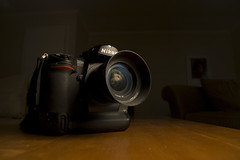 Next we'll add a little flash, in the form of an SB-26 in a shoot-through umbrella. Please forgive the umbrella ribs reflection in the front filter. I was working fast today. Besides, I had already made my artistic statement for the day and I was too bushed to be creative again.
Next we'll add a little flash, in the form of an SB-26 in a shoot-through umbrella. Please forgive the umbrella ribs reflection in the front filter. I was working fast today. Besides, I had already made my artistic statement for the day and I was too bushed to be creative again.But wait, what's that light on the back wall? Well, we already know that it isn't ambient, so it must be flash. Which is exactly what it is -- spill light from the umbrella.
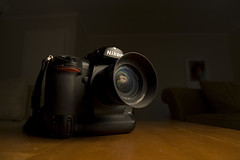 So, let's open the shutter speed up two thirds of a stop to a 1/160th of a second.
So, let's open the shutter speed up two thirds of a stop to a 1/160th of a second. Hmm. The background doesn't get any brighter.
Same thing for 1/100th and 1/60th. (Okay, maybe a tiny bit at 1/60th.)
This is simply because we are working so far from the ambient exposure of the room. If the flash is much more powerful than a given, combined ambient setting, I call that "working above the ambient," as in, "I was shooting flash at f/4, working 4 stops above the ambient."
That tells you that at f/4, my chosen shutter speed was four stops too high for the ambient exposure.
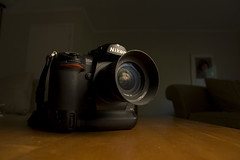 It's not until we get to 1/40th of a second that the ambient starts to creep in, albeit barely.
It's not until we get to 1/40th of a second that the ambient starts to creep in, albeit barely.This is the threshold of the shutter settings at f/4 (and ISO 200) that will allow the ambient to burn into the flash's shadow areas in the photo. So here is where you'd start paying close attention to the TFT screen and adjusting your shutter to get the best effect.
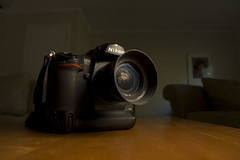 At a shutter speed of 1/25th of a second, things are starting to happen.
At a shutter speed of 1/25th of a second, things are starting to happen.Clearly the ambient is starting to make a more pronounced appearance here. Mind you, the camera is staying consistent because it is lit solely by the flash at this point.
The background isn't really usable at this point, exposure-wise. But the light is coming up and I am confident that I can fine-tune it to whatever tone I want.
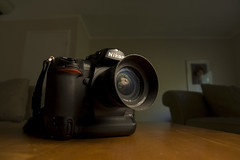 At a 15th of a second, the background is getting usable.
At a 15th of a second, the background is getting usable.From here on out (or up, actually) the tone of the background becomes a personal choice. There is no "wrong," as it is now a matter of how much separation I want between the subject and the background.
Remember when we told you to throw the concept of "proper exposure" out of the window? This is what I am talking about: The the exposure reference point is set by how you choose to expose the light falling on the camera. The background can be anywhere in a wide range of tones, with the choice being yours.
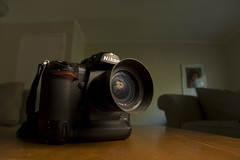 At a tenth of a second, my off-white wall is a rich tone, influenced as much by the color of the green-filtered shady light coming through the north-facing window as it is by the ambient portion of the exposure.
At a tenth of a second, my off-white wall is a rich tone, influenced as much by the color of the green-filtered shady light coming through the north-facing window as it is by the ambient portion of the exposure.Doing an exercise like this (hint, hint) will show you just how much control you have over a situation once you start to understand the concept of balancing strobe and ambient.
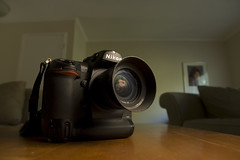 At a 6th of a second, we are still below medium grey on the tonal level of the background. But now we are starting to get into a background range that, say, a newspaper might be able to reproduce.
At a 6th of a second, we are still below medium grey on the tonal level of the background. But now we are starting to get into a background range that, say, a newspaper might be able to reproduce.The ultimate medium in which the photo is going to be reproduced will be your guide as to the limits of your chosen ambient fill level. But again, the choice within that range is yours.
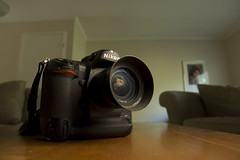 One quarter of a sec.
One quarter of a sec.This is my personal choice, as I like the "invisible" quality of the light and ambient combo for this picture. It's a subjective call, but for something like this the light can be made to disappear (not too obvious) and the photo just has a quality edge to it that does not look lit, but just looks nice.
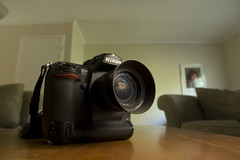 At 0.4 secs (1/2.5) the room starts getting airy.
At 0.4 secs (1/2.5) the room starts getting airy. Remember, the walls are well above medium grey, so the camera considers this an overexposure of the ambient. Again, that "proper exposure" thing is a very fudgeable concept. You might like this frame better. There really is no right or wrong here.
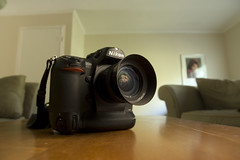 At 0.6 secs, the background looks airier still.
At 0.6 secs, the background looks airier still.I could go up more on he ambient, but the highlights in the center right portion of the background would start to blow out, which would be distracting (but still not "wrong," IMO.) There is more leeway here than in a Composition 101 paper in 9th grade.
The first concept that you have to learn is that there is a base exposure that will render any scene as black. Indoors, this is frequently an easy exposure to achieve while still being at or below your synch speed. From there, merely opening up the shutter will allow progressively more ambient light into your photo until you get exactly the balance that you want.
Here's something else to think about: Your tripod is another flash unit, but with near-infinite power. Say you are shooting in a huge, cavernous, dimly lit, windowless room. You could umbrella-light someone with a flash in the foreground, and just hold that shutter open until the room was raised exactly to the supporting exposure that you wished. Just lock your camera down on a tripod and leave the shutter open until the whole, "unlit" portion of the room burns in.
I have done it (on a tripod) for 30 seconds at f/2.8. The person swayed just a tad during the exposure. But honestly, that made it look even better. And speaking of movement, one last shot:
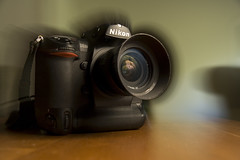 Given a quarter second of shutter with which to play, of course I am gonna try a little flash-blur.
Given a quarter second of shutter with which to play, of course I am gonna try a little flash-blur. But that's not until Part 7, so let's save that for later.
____________________________________
We still haven't finished the balance unit. So this week's exercise is just that, rather than an assignment.
I did these demo shots in ten minutes, literally, from light setup to final frame. It's really no big deal to try something like this in your living room.
The important thing to remember (as it always is when "burning in" ambient against flash) is to have your flash-lit subject in a part of the scene that is receiving less ambient light than the ambient-lit part of the scene. In practice, this usually means shooting into a brighter background and lighting your subject with flash in the foreground.
Remember, the whole distance thing still applies. So keep that flash in close, lest it contaminate your background.
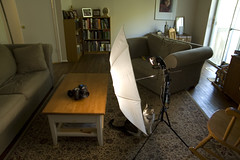 FYI, here is a shot which shows the incredibly difficult and complex setup that was used to make this series of shots.
FYI, here is a shot which shows the incredibly difficult and complex setup that was used to make this series of shots.(That's "Ginger" sniffing the umbrella, by the way. She's not the brightest bulb in a three-pack, but she's very sweet.)
One final note on the umbrella: I "choked up" on the shaft a little but, which means that I did not make full use of the full umbrella as a light source. Reason is (other than that I did not need the full light source at this small distance for the light to be soft) is that I did not want any raw light to spill past the edges of my umbrella and further light the background.
If you are doing the exercises, please tag your photo(s) thusly:
Strobist
Lighting102
exercise
balance
indoors
You can view the completed exercises of others, here. There is a discussion thread set up for this post here.
Finally, given the range of background tones that would have been displayed on the back of your camera, which shutter speed would you have chosen, and why?
Hit us in the comments.
NEXT: Assignment: Balance




0 comments:
Post a Comment